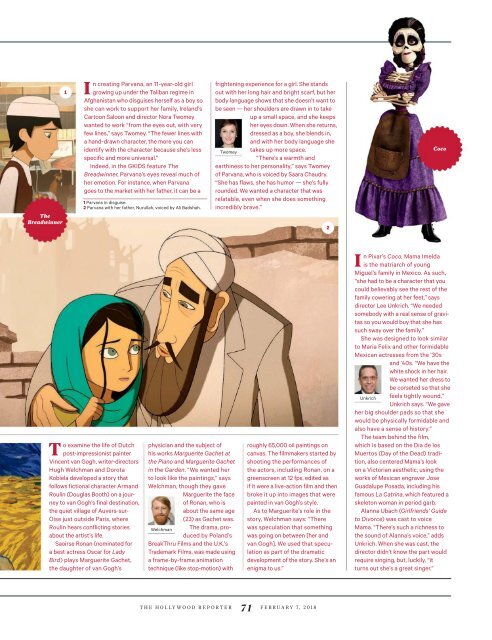You also want an ePaper? Increase the reach of your titles
YUMPU automatically turns print PDFs into web optimized ePapers that Google loves.
<strong>The</strong><br />
Breadwinner<br />
1<br />
I<br />
n creating Parvana, an 11-year-old girl<br />
growing up under the Taliban regime in<br />
Afghanistan who disguises herself as a boy so<br />
she can work to support her family, Ireland’s<br />
Cartoon Saloon and director Nora Twomey<br />
wanted to work “from the eyes out, with very<br />
few lines,” says Twomey. “<strong>The</strong> fewer lines with<br />
a hand-drawn character, the more you can<br />
identify with the character because she’s less<br />
specific and more universal.”<br />
Indeed, in the GKIDS feature <strong>The</strong><br />
Breadwinner, Parvana’s eyes reveal much of<br />
her emotion. For instance, when Parvana<br />
goes to the market with her father, it can be a<br />
1 Parvana in disguise.<br />
2 Parvana with her father, Nurullah, voiced by Ali Badshah.<br />
frightening experience for a girl. She stands<br />
out with her long hair and bright scarf, but her<br />
body language shows that she doesn’t want to<br />
be seen — her shoulders are drawn in to take<br />
up a small space, and she keeps<br />
her eyes down. When she returns,<br />
dressed as a boy, she blends in,<br />
and with her body language she<br />
Twomey<br />
takes up more space.<br />
“<strong>The</strong>re’s a warmth and<br />
earthiness to her personality,” says Twomey<br />
of Parvana, who is voiced by Saara Chaudry.<br />
“She has flaws, she has humor — she’s fully<br />
rounded. We wanted a character that was<br />
relatable, even when she does something<br />
incredibly brave.”<br />
2<br />
Coco<br />
T<br />
o examine the life of Dutch<br />
post-impressionist painter<br />
Vincent van Gogh, writer-directors<br />
Hugh Welchman and Dorota<br />
Kobiela developed a story that<br />
follows fictional character Armand<br />
Roulin (Douglas Booth) on a journey<br />
to van Gogh’s final destination,<br />
the quiet village of Auvers-sur-<br />
Oise just outside Paris, where<br />
Roulin hears conflicting stories<br />
about the artist’s life.<br />
Saoirse Ronan (nominated for<br />
a best actress Oscar for Lady<br />
Bird) plays Marguerite Gachet,<br />
the daughter of van Gogh’s<br />
physician and the subject of<br />
his works Marguerite Gachet at<br />
the Piano and Marguerite Gachet<br />
in the Garden. “We wanted her<br />
to look like the paintings,” says<br />
Welchman, though they gave<br />
Marguerite the face<br />
of Ronan, who is<br />
about the same age<br />
(23) as Gachet was.<br />
Welchman<br />
<strong>The</strong> drama, produced<br />
by Poland’s<br />
BreakThru Films and the U.K.’s<br />
Trademark Films, was made using<br />
a frame-by-frame animation<br />
technique (like stop-motion) with<br />
roughly 65,000 oil paintings on<br />
canvas. <strong>The</strong> filmmakers started by<br />
shooting the performances of<br />
the actors, including Ronan, on a<br />
greenscreen at 12 fps, edited as<br />
if it were a live-action film and then<br />
broke it up into images that were<br />
painted in van Gogh’s style.<br />
As to Marguerite’s role in the<br />
story, Welchman says: “<strong>The</strong>re<br />
was speculation that something<br />
was going on between [her and<br />
van Gogh]. We used that speculation<br />
as part of the dramatic<br />
development of the story. She’s an<br />
enigma to us.”<br />
I<br />
n Pixar’s Coco, Mama Imelda<br />
is the matriarch of young<br />
Miguel’s family in Mexico. As such,<br />
“she had to be a character that you<br />
could believably see the rest of the<br />
family cowering at her feet,” says<br />
director Lee Unkrich. “We needed<br />
somebody with a real sense of gravitas<br />
so you would buy that she has<br />
such sway over the family.”<br />
She was designed to look similar<br />
to Maria Felix and other formidable<br />
Mexican actresses from the ’30s<br />
and ’40s. “We have the<br />
white shock in her hair.<br />
We wanted her dress to<br />
be corseted so that she<br />
Unkrich<br />
feels tightly wound,”<br />
Unkrich says. “We gave<br />
her big shoulder pads so that she<br />
would be physically formidable and<br />
also have a sense of history.”<br />
<strong>The</strong> team behind the film,<br />
which is based on the Dia de los<br />
Muertos (Day of the Dead) tradition,<br />
also centered Mama’s look<br />
on a Victorian aesthetic, using the<br />
works of Mexican engraver Jose<br />
Guadalupe Posada, including his<br />
famous La Catrina, which featured a<br />
skeleton woman in period garb.<br />
Alanna Ubach (Girlfriends’ Guide<br />
to Divorce) was cast to voice<br />
Mama. “<strong>The</strong>re’s such a richness to<br />
the sound of Alanna’s voice,” adds<br />
Unkrich. When she was cast, the<br />
director didn’t know the part would<br />
require singing, but, luckily, “it<br />
turns out she’s a great singer.”<br />
THE HOLLYWOOD REPORTER<br />
71<br />
FEBRUARY 7, <strong>2018</strong>



